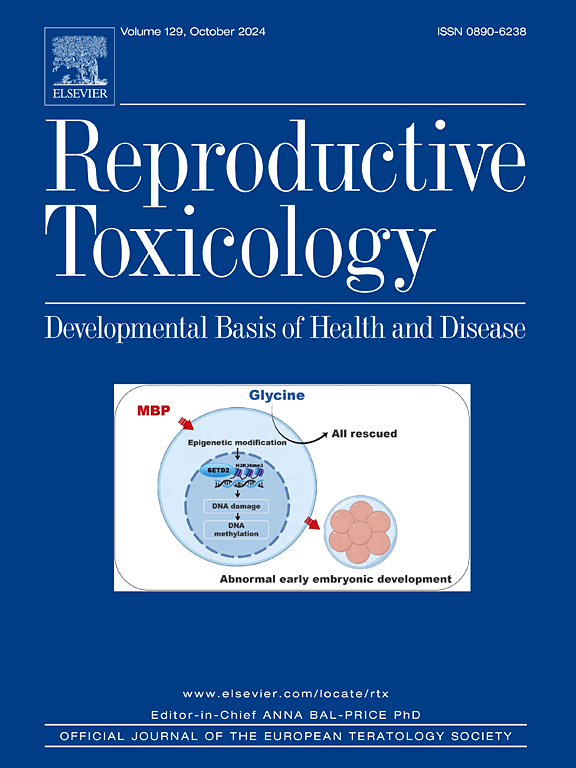Neurocognitive impairments in rat offspring after maternal exposure to vortioxetine: Involvement of BDNF, apoptosis and cholinergic mediated signaling pathways
IF 3.3
4区 医学
Q2 REPRODUCTIVE BIOLOGY
引用次数: 0
Abstract
Depression in pregnant women raises concerns about the safety of antidepressants use, particularly its impact on offspring’s neurocognition. This study investigates the effects of maternal exposure to vortioxetine (VOX) on the neurocognitive development of rat offspring. Pregnant Wistar rats were administered clinically pertinent doses of VOX, 1 mg/kg/day or 2 mg/kg/day from gestational day 6–21. The dams delivered their offspring naturally and reared until postnatal day (PND) 70. Offspring of both sexes were assessed for postnatal growth by measuring body weight from PND 1–70 weekly and cognitive function using Morris water maze (MWM) test and passive avoidance learning test from PND 49–70. After behavioral assessments, adult rat offspring were sacrificed, and their brains were dissected out for assessment of brain morphology as well as biochemical analysis. The results demonstrated that VOX exposure potentially impaired cognitive performance, evidenced by increased latency in MWM and passive avoidance learning tests. Additionally, it led to decreased body weight, altered brain morphology, and disrupted neurobiochemical profiles. Specifically, VOX 2 mg/kg exposure significantly reduced brain-derived neurotrophic factor (BDNF) expression, increased pro-apoptotic BAX expression, decreased anti-apoptotic Bcl-2 expression, and elevated acetylcholinesterase (AChE) activity in the hippocampus. Lower dose of VOX (1 mg/kg) did not show significant adverse effects on neurocognition, suggesting a dose-dependent impact. No sex specific neurocognitive deficits were observed in current study. These findings indicate that while VOX may offer a safer profile compared to SSRIs, high doses during pregnancy can still result in neurocognitive impairments in offspring.
大鼠后代在母体接触伏替西汀后出现神经认知障碍:BDNF、细胞凋亡和胆碱能介导的信号通路的参与。
孕妇抑郁症引发了人们对抗抑郁药物使用安全性的担忧,尤其是其对后代神经认知的影响。本研究调查了母体接触伏替西汀(VOX)对大鼠后代神经认知发育的影响。从妊娠第 6 天到第 21 天,给妊娠 Wistar 大鼠服用临床相关剂量的 VOX(1 毫克/千克/天或 2 毫克/千克/天)。母鼠自然分娩后代,并饲养至出生后第 70 天。雌雄大鼠的后代在出生后第 1 天至第 70 天期间每周通过测量体重来评估其生长情况,在出生后第 49 天至第 70 天期间通过莫里斯水迷宫(MWM)测试和被动回避学习测试来评估其认知功能。行为评估结束后,成年后代大鼠被处死,并剖开其大脑进行脑形态评估和生化分析。结果表明,暴露于 VOX 可能会损害认知能力,表现为 MWM 和被动回避学习测试的潜伏期延长。此外,它还会导致体重下降、大脑形态改变和神经生化特征紊乱。具体来说,暴露于2毫克/千克的VOX会显著降低脑源性神经营养因子(BDNF)的表达,增加促凋亡BAX的表达,降低抗凋亡Bcl-2的表达,并升高海马中乙酰胆碱酯酶(AChE)的活性。较低剂量的 VOX(1 毫克/千克)对神经认知没有明显的不良影响,表明其影响与剂量有关。本研究未观察到性别特异性神经认知障碍。这些研究结果表明,虽然与 SSRIs 相比,VOX 具有更安全的特性,但孕期大剂量用药仍会导致后代出现神经认知障碍。
本文章由计算机程序翻译,如有差异,请以英文原文为准。
求助全文
约1分钟内获得全文
求助全文
来源期刊

Reproductive toxicology
生物-毒理学
CiteScore
6.50
自引率
3.00%
发文量
131
审稿时长
45 days
期刊介绍:
Drawing from a large number of disciplines, Reproductive Toxicology publishes timely, original research on the influence of chemical and physical agents on reproduction. Written by and for obstetricians, pediatricians, embryologists, teratologists, geneticists, toxicologists, andrologists, and others interested in detecting potential reproductive hazards, the journal is a forum for communication among researchers and practitioners. Articles focus on the application of in vitro, animal and clinical research to the practice of clinical medicine.
All aspects of reproduction are within the scope of Reproductive Toxicology, including the formation and maturation of male and female gametes, sexual function, the events surrounding the fusion of gametes and the development of the fertilized ovum, nourishment and transport of the conceptus within the genital tract, implantation, embryogenesis, intrauterine growth, placentation and placental function, parturition, lactation and neonatal survival. Adverse reproductive effects in males will be considered as significant as adverse effects occurring in females. To provide a balanced presentation of approaches, equal emphasis will be given to clinical and animal or in vitro work. Typical end points that will be studied by contributors include infertility, sexual dysfunction, spontaneous abortion, malformations, abnormal histogenesis, stillbirth, intrauterine growth retardation, prematurity, behavioral abnormalities, and perinatal mortality.
 求助内容:
求助内容: 应助结果提醒方式:
应助结果提醒方式:


